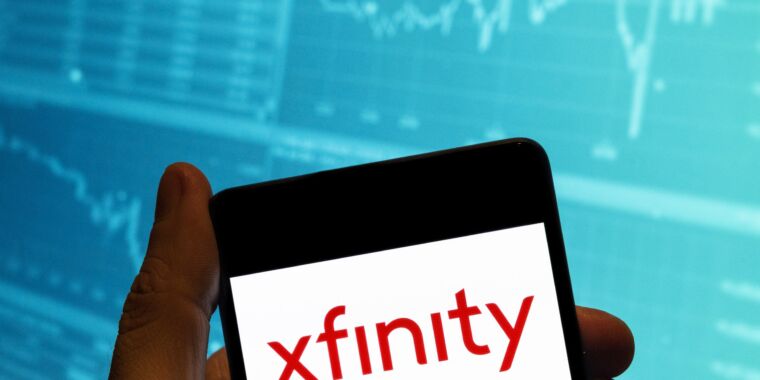
Getty Images | SOPA Images
An advertising industry group urged Comcast to stop its “10G” ads or modify them to state that 10G is an “aspirational” technology rather than something the company actually provides on its cable network today. The National Advertising Division (NAD), part of the advertising industry’s self-regulatory system run by BBB National Programs, ruled against Comcast after a challenge lodged by T-Mobile.
In its decision announced Thursday, the NAD recommended that Comcast “discontinue its ’10G’ claims” or “modify its advertising to (a) make clear that it is implementing improvements that will enable it to achieve ’10G’ and that it is aspirational or (b) use ’10G’ in a manner that is not false or misleading, consistent with this decision.”
Comcast plans to appeal the decision, so it won’t make any changes to marketing immediately. If Comcast loses the appeal and agrees to change its practices, it would affect more than just a few ads because Comcast now calls its entire broadband network “10G.”
“In February 2023, Comcast rebranded its fixed Internet network as ‘Xfinity 10G Network’ to signify technological upgrades to its network that are continuing to be implemented,” the NAD said.
Comcast’s website claims that the “Xfinity 10G Network is already here! You’ll see continual increases in network speed and reliability. No action is required on your part to join the Xfinity 10G Network.” It also claims that 10G is “complementary” to the 5G mobile network.
Confusing cable marketing
Comcast isn’t alone in its use of the 10G term, which was unveiled in January 2019 by cable industry trade group NCTA-The Internet & Television Association. We wrote at the time that 10G marketing was likely to confuse consumers and that it indicated cable companies were envious of the 5G hype generated by the wireless industry.
While 5G refers to the fifth generation of cellular services, the cable industry’s 10G term referred to the long-term goal of providing 10Gbps broadband speeds over cable wires through upgrades to DOCSIS, the Data Over Cable Service Interface Specification. The NCTA explicitly acknowledged that in its 2019 announcement, saying that 10G is all about delivering 10Gbps speeds over cable.
But if you want 10Gbps wired broadband today—especially if you want it for both uploads and downloads—you need fiber, not cable. Comcast sort of admits that on its website, acknowledging that what it calls “the Xfinity 10G Network is different from 10Gbps.” 10G, according to Comcast, is “a holistic combination of its reliability, security, power, resilience and speed.”
The NAD was not convinced by the distinctions Comcast draws between 10G and 10Gbps and between 10G and 5G. The industry group said it “concluded that ’10G’ as used in the name ‘Xfinity 10G Network’ and ‘Xfinity 10G’ is an express claim that means 10Gbps or 10th Generation.” The NAD continued:
In evaluating support for this claim, NAD found that Comcast’s description of its entire network as “10G” conveys the message that all consumers on the network will receive a significant increase in speed up to 10Gbps speeds. However, only one of Xfinity’s many plans (Gigabit Pro) can reach 10Gbps, and to access that service tier requires the installation of fiber to the premises. Further, NAD determined that the evidence in the record was insufficient to support the broad, unqualified message that the “Xfinity 10G Network” is vastly superior to 5G.
The NAD said it “concluded that Comcast did not provide a reasonable basis for its 10G claims” and recommended that Comcast discontinue or modify how it uses the marketing terms “10G,” “Xfinity 10G,” and “Xfinity 10G Network.”
Comcast disagrees with ad group
Comcast said it will file an appeal with the National Advertising Review Board because it “disagrees with NAD’s decision, including NAD’s determination that the Xfinity 10G Network brand name constitutes an ‘express claim.'” Comcast declined to provide any further comment when contacted by Ars today.
Comcast announced in June that it upgraded the Gigabit Pro fiber-to-the-home service to 10Gbps for both downloads and uploads. But a Gigabit Pro fiber connection is not available to all homes in Comcast’s cable territory, and it costs $299.95 a month plus a $19.95 modem lease fee. It also requires a $500 installation charge and a $500 activation charge.
For its asymmetrical cable service, Comcast prominently advertises download speeds but makes it difficult for customers to even figure out what upload speeds are before deciding on a plan. For many years, Comcast’s cable upload speeds topped out at 35Mbps even if you bought gigabit download speeds.
Comcast started offering cable upload speeds as high as 200Mbps late last year, but only if you bought the $25 per-month “xFi Complete” add-on that included a gateway rental. Comcast notified customers a few months ago that it was removing the xFi Complete requirement for higher uploads as long as you have a compatible Xfinity gateway or third-party modem.
It is now possible for some Comcast customers to obtain multi-gigabit upload speeds over cable, though not the 10Gbps suggested by Comcast’s 10G marketing. Last week, Comcast announced that “select neighborhoods” in a few markets are getting 2Gbps upload and download speeds over cable via DOCSIS 4.0.








